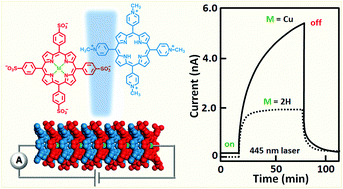当前位置:
X-MOL 学术
›
J. Mater. Chem. C
›
论文详情
Our official English website, www.x-mol.net, welcomes your
feedback! (Note: you will need to create a separate account there.)
Tuning the optoelectronic characteristics of ionic organic crystalline assemblies†
Journal of Materials Chemistry C ( IF 5.7 ) Pub Date : 2018-03-22 00:00:00 , DOI: 10.1039/c8tc00416a Bryan Borders 1, 2, 3, 4 , Morteza Adinehnia 1, 2, 3, 4 , Bhaskar Chilukuri 1, 2, 3, 4 , Michael Ruf 4, 5, 6 , K. W. Hipps 1, 2, 3, 4 , Ursula Mazur 1, 2, 3, 4
Journal of Materials Chemistry C ( IF 5.7 ) Pub Date : 2018-03-22 00:00:00 , DOI: 10.1039/c8tc00416a Bryan Borders 1, 2, 3, 4 , Morteza Adinehnia 1, 2, 3, 4 , Bhaskar Chilukuri 1, 2, 3, 4 , Michael Ruf 4, 5, 6 , K. W. Hipps 1, 2, 3, 4 , Ursula Mazur 1, 2, 3, 4
Affiliation

|
The effect of selective metallation of free-base ionic porphyrin tectons on the structural, electronic, and optical properties of their crystalline self-assemblies is presented. Rod-like crystals were prepared under neutral pH conditions by combining meso-tetra(N-methyl-pyridyl)porphyrin, H2TMPyP, and meso-tetra(4-sulfonatophenyl)porphyrin, H2TSPP, with either a nickel or a copper ion contained in one of the synthons. These materials were characterized by optical microscopy, X-ray diffraction methods, thermogravimetric analysis, diffuse reflectance UV-visible and luminescence spectroscopies, and conductivity and photoconductivity measurements. All the porphyrin assemblies formed monoclinic P21/c crystals with pseudo-hexagonal cross-sections. Thermogravimetric experiments indicate that water molecules associated with crystals desorb at two different rates. In addition, temperature dependent XRD showed that the dehydration of the porphyrin solids causes modification in the crystals which is completely reversible up to 100 °C annealing (i.e., crystals return to their original structural geometry upon rehydration). All the metallated porphyrin crystals exhibit dark conductivity at moderately high temperatures and become more conductive upon photoexcitation. The photoresponse of the H2TMPyP:CuTSPP-substituted crystals is significantly higher than that of the CuTMPyP:H2TSPP and the Ni-substituted crystals. The Cu-substituted systems, like the parent free-base, exhibit persistent photoconductivity resulting from excitations into the Q and Soret bands. The primary charge carriers in these solids upon photoexcitation are electrons and the charge recombination mechanism follows monomolecular kinetics. Quantum mechanical calculations provide the electronic band structure and the density of states and explain the experimental prompt photoconductivity measurements of the porphyrin self-assemblies. This work provides evidence that optoelectronic properties of organic semiconductors can be effectively tuned by introducing transition metals into their crystal structures.
中文翻译:

调整离子有机晶体组件的光电特性†
提出了选择性碱金属化的游离碱离子卟啉构造对其晶体自组装体的结构,电子和光学性质的影响。棒状晶体是在中性pH条件下通过将内消旋-四(N-甲基-吡啶基)卟啉,H 2 TMPyP和中消旋-四(4-磺酰基苯基)卟啉,H 2 TSPP与镍或铜结合而制备的合成子之一中包含的离子。这些材料通过光学显微镜,X射线衍射法,热重分析,紫外可见分光光度法和发光光谱法以及电导率和光电导率测量来表征。所有的卟啉组装体形成单斜晶P具有假六边形截面的2 1 / c晶体。热重实验表明,与晶体相关的水分子以两种不同的速率解吸。此外,取决于温度的XRD显示,卟啉固体的脱水会导致晶体发生改性,直到100°C退火,这种改性是完全可逆的(即,晶体在重新水化后恢复其原始结构几何形状)。所有金属化的卟啉晶体在中等高温下均表现出暗电导率,并且在光激发下变得更具导电性。H 2 TMPyP:CuTSPP取代的晶体的光响应显着高于CuTMPyP:H 2的晶体TSPP和Ni取代的晶体。像母体游离碱一样,铜取代的系统表现出持久的光电导性,这是由激发到Q和Soret谱带中引起的。这些固体在光激发后的主要电荷载体是电子,电荷复合机理遵循单分子动力学。量子力学计算提供了电子能带结构和态密度,并解释了卟啉自组装的实验快速光电导测量。这项工作提供了证据,证明可以通过将过渡金属引入其晶体结构来有效地调节有机半导体的光电特性。
更新日期:2018-03-22
中文翻译:

调整离子有机晶体组件的光电特性†
提出了选择性碱金属化的游离碱离子卟啉构造对其晶体自组装体的结构,电子和光学性质的影响。棒状晶体是在中性pH条件下通过将内消旋-四(N-甲基-吡啶基)卟啉,H 2 TMPyP和中消旋-四(4-磺酰基苯基)卟啉,H 2 TSPP与镍或铜结合而制备的合成子之一中包含的离子。这些材料通过光学显微镜,X射线衍射法,热重分析,紫外可见分光光度法和发光光谱法以及电导率和光电导率测量来表征。所有的卟啉组装体形成单斜晶P具有假六边形截面的2 1 / c晶体。热重实验表明,与晶体相关的水分子以两种不同的速率解吸。此外,取决于温度的XRD显示,卟啉固体的脱水会导致晶体发生改性,直到100°C退火,这种改性是完全可逆的(即,晶体在重新水化后恢复其原始结构几何形状)。所有金属化的卟啉晶体在中等高温下均表现出暗电导率,并且在光激发下变得更具导电性。H 2 TMPyP:CuTSPP取代的晶体的光响应显着高于CuTMPyP:H 2的晶体TSPP和Ni取代的晶体。像母体游离碱一样,铜取代的系统表现出持久的光电导性,这是由激发到Q和Soret谱带中引起的。这些固体在光激发后的主要电荷载体是电子,电荷复合机理遵循单分子动力学。量子力学计算提供了电子能带结构和态密度,并解释了卟啉自组装的实验快速光电导测量。这项工作提供了证据,证明可以通过将过渡金属引入其晶体结构来有效地调节有机半导体的光电特性。











































 京公网安备 11010802027423号
京公网安备 11010802027423号